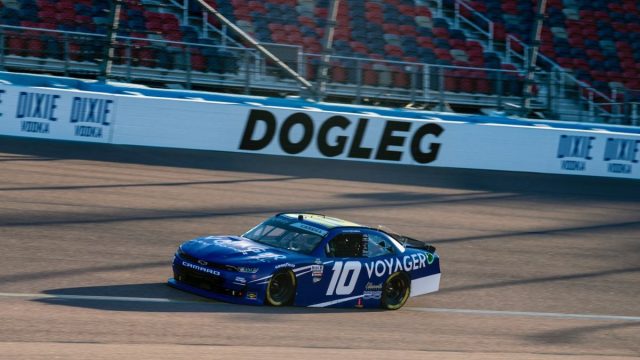What Is NASCAR’s Dogleg: In NASCAR racing, there exists a feature that has garnered fascination and trepidation among the drivers and fans: the infamous Dogleg.
This enigmatic turn, shrouded in mystery and challenge, has long been a subject of intrigue within the racing community. As we uncover this track element, we come across a hidden nightmare that tests the skills and mettle of even the most seasoned drivers.
Join us as we explore the secrets behind NASCAR’s Dogleg and the griping tales of triumph and turmoil that unfold within its twists and turns.
Introduction to Dogleg in NASCAR Racing
The introduction of a dogleg in NASCAR racing brings a unique and challenging element to the track, requiring the drivers to navigate through a distinctive feature that adds complexity and unpredictability to the circuit. Shaped like the hindleg of a dog, the dogleg is strategically designed to slow down the drivers or inject a dose of uncertainty into the race. In NASCAR, the Phoenix International Raceway stands out for its intriguing and demanding dogleg section, considered one of the most engaging and challenging in the sport.
Drivers approaching the dogleg must carefully maneuver through the two angles that make up this feature, testing their skills and precision. This element demands a blend of speed, control, and strategy from the drivers, as they must adjust their racing line to tackle the dogleg efficiently while maintaining their position on the track. The dogleg not only complicates overtaking maneuvers but also adds an exciting twist to the race, keeping both the drivers and spectators on the edge of their seats as the cars navigate this unique section of the track.

Phoenix Raceway’s Reconfiguration and the Impact on the Dogleg
Following the reconfiguration of Phoenix Raceway in 2011, significant changes were made to the track layout, particularly impacting the challenging dogleg section. The alterations implemented have reshaped the dynamics of this section, making it a crucial point for the drivers to navigate effectively. Here are some key impacts of the reconfiguration on the dogleg:
- Tightened Corner: The reconfiguration tightened the existing dogleg, making it more challenging for the drivers to maneuver through this section smoothly.
- Integration of New Pit Exit: A new pit exit was integrated into the design, necessitating paving beneath the dogleg. This change added an extra layer of complexity to an already demanding corner.
- Increased Demands on Drivers: The combination of these adjustments has increased the demands on the drivers, requiring precise handling and strategic decision-making to tackle the dogleg effectively.
- Distinctive and Challenging Corner: The reconfiguration has transformed the dogleg into a distinctive and challenging corner, testing the skills and adaptability of the drivers on the track.
Driver Strategies and Insights on Navigating the Dogleg
With the NASCAR Cup Series race at Phoenix fast approaching, drivers are strategically honing their skills to master the demanding dogleg section, aiming to gain a competitive edge on the track. Denny Hamlin, among other drivers, has shared insights into their strategies for navigating this challenging feature.
As drivers seek to leverage the dogleg for overtaking opportunities, they must also be vigilant in defending against aggressive maneuvers from the competitors. Hamlin highlighted the critical role of the dogleg in race strategy, noting its increased importance following modifications in car design.
Understanding the variations of this section of the track, such as the optimal line to take and the timing of maneuvers, will be key in determining success during the race. Drivers are expected to employ a mix of skills, precision, and tactical awareness to navigate the dogleg effectively and maximize their performance on the track.

News in Brief
Phoenix Raceway’s dogleg, a captivating and challenging feature in NASCAR, has long intrigued drivers and fans alike. Shaped like a dog’s hindleg, it tests drivers’ skills with its unique angles. Following Phoenix Raceway’s 2011 reconfiguration, the dogleg became even more demanding, featuring a tightened corner and the integration of a new pit exit. As the NASCAR Cup Series race approaches, drivers, including Denny Hamlin, strategically prepare to navigate this crucial section. Hamlin emphasizes the dogleg’s role in race strategy, highlighting its increased importance post-car design modifications. Mastering the dogleg requires a blend of precision, skill, and strategic awareness as drivers aim for success on the challenging Phoenix track.
Our Reader’s Queries
Q. What is the dogleg at Phoenix Raceway?
A. Due to the challenging terrain and the inclusion of a road course and drag strip, the designers faced the necessity of constructing a distinctive “dogleg” on the backstretch. The original road course spanned 2.700 miles (4.345 km), intricately weaving both inside and outside of the main oval track for a dynamic and diverse racing experience.
Q. What is the wave around in NASCAR?
A. The “wave around” strategy comes into play when a driver is a lap down but doesn’t qualify for the free pass. When the leaders decide to pit under caution, lapped cars can take advantage of the wave around. This tactic permits those cars to circulate the track and regain a lap, similar to the free pass option, providing an opportunity for strategic recovery during caution periods.
ALSO READ: NASCAR’s Phoenix Package Flops: Drivers Disappointed in New Changes
